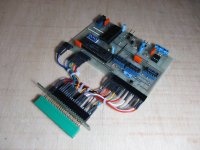I've never heard of such an interface and I'm a long time Sinclair fan, but that doesn't mean they didn't exist - a lot of stuff was lost to history around the zx80 and 81.
It's not difficult to connect something like an 8251 to the zx80 and use it as a serial transceiver, but the ROM won't support it, and there's nothing like the Interface 1 for the zx81.
That means either programming the chip directly from machine code, or via IN and OUT from basic. That's doable, though would require you to wire up an interface still.
You have enough port pins at the edge connector to wire up a serial chip, and then all you need is some basic port decoding, maybe a QUAD OR gate would do it, and a hex inverter, and that's enough to build an oscillator too, for the clock input to the serial chip - so the whole thing is about 3 chips to get to TTL serial, and four chips ( add a MAX232 ) if you want to connect to a printer rather than a PC serial interface with TTL signals. A lot simpler than the provided schematic.
There were also some modems - I think that the Prism worked with the Spectrum or the zx81 ( I could be wrong ) but if you wanted a ready made circuit, then this would be another path - Just intercept the data from the serial chip directly and disconnect the analog modem circuit. Any modems for the zx81 would include all of the necessary serial port interface already made.
The final option is to wire something up from the Spectrum - eg, Find a serial port for the spectrum and cut down the connector. It's mostly higher address likes at the edge, but it should be relatively simple to adapt a Spectrum serial port to the zx81 and find some suitable I/O port mappings that likely won't be any more difficult than remapping some wires - Maybe not even that much given how much a Spectrum shares with the zx81 port-wise.
Hand wiring such a project is realistic also - it's not too complex. A few hours with a soldering iron and some prototyping PCB. It was the older serial chips that were more complex as they often omitted a baud rate generator while the newer 8251s had that built in, and if you go for something like an 80c750, you can get a 64 byte FIFO buffer as well, which will help a lot talking to a zx81.
Something like this is very likely to be adaptable to the zx81 with minimal rewiring:
https://www.computinghistory.org.uk/det/42243/Indescomp-Parallel-Serial-Interface/
It may not even use any different pins - and simply cutting the interface down might be all you need?

